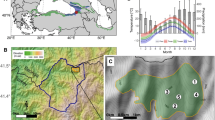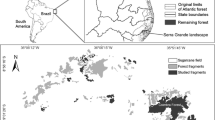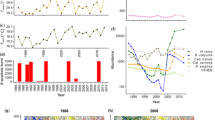Abstract
Size and age structure, spatial analysis, and disturbance history were used to analyse the population structures and regeneration patterns of 8 conifer stands in the central western Cascade Range, Oregon, USA. Variation in forest structure reflected the effects of frequent (20–50 yr) low-intensity fires and treefalls, infrequent (100–200 yr) localised, intense fires, and extensive fires that resulted in stand replacement (every ca 400 yr?).
The amount of canopy removed and the size of openings formed by fires and treefalls were important determinants of subsequent forest establishment. Single or several species stands of Pseudotsuga and/or Abies procera, or mixed species stands of Pseudotsuga, Abies procera, Tsuga heterophylla and Abies amabilis established in openings where intense fires had removed most of the canopy trees over several ha. Multi-tiered and multi-aged stands, often containing 400–500 yr-old Pseudotsuga and variously-sized more or less even-aged patches of younger shade tolerant Tsuga heterophylla and/or Abies amabilis, occurred where lower-intensity fires did not kill all overstorey trees or where treefalls occurred after the initial fire.
Current regeneration processes are influenced by overstorey composition, the availability and size of canopy openings, and the availability of substrates suitable for regeneration. Tsuga heterophylla and Abies amabilis established under Pseudotsuga menziesii and Abies procera canopies and in small canopy openings (<400 m2) created by windfalls, but rarely under Tsuga. Down logs and stumps were favoured establishment sites for Tsuga.
The disturbance regime of fires of low-to moderate-intensity, windfalls, and occasional fires that result in extensive stand replacement contrasts with the pattern of infrequent, catastrophic disturbances proposed for other areas of the Pacific Northwest. Although fires at stand establishment commonly determine much of the composition, structure, and subsequent stand development, canopy replacement by shade tolerant species occurs as the different life histories of the species are expressed in response to various disturbances differing in intensity and frequency. Such a non-equilibrium view of vegetation change is consistent with many other fire-dominated forests of the western United States.
Similar content being viewed by others
References
Anderson, M.C. 1964a. Studies of the woodland light climate. I. the photographic computation of light conditions. J. Ecol. 52: 27–41.
Anderson, M.C. 1964b. Studies of the woodland light climate. II. Seasonal variation in the light climate. J. Ecol. 52: 643–663.
Aplet, G.H., Laven, R.D. & Smith, F.W. 1988. Patterns of community dynamics in Colorado Englemann sprucesubalpine fir forests. Ecology 69: 312–319.
Bonnicksen, T.M. & Stone, E.C. 1981. The giant sequoiamixed conifer forest community characterized through pattern analysis as a mosaic of aggregations. For. Ecol. Manag. 3: 307–328.
Bormann, F.H. & Likens, G.E. 1979. Pattern and process in a forested ecosystem. Springer-Verlag, New York, USA.
Burke, C.J., 1979. Historic fires in the central western Cascades, Oregon, M.S. thesis, Oregon State University, Corvallis, Oregon, USA.
Drury, W.H. & Nisbet, I.C.T. 1973. Succession. J. Arnold Arbor. 54: 331–368.
Dyrness, C.T. Franklin, J.F. & Moir, W.H. 1974. A preliminary classification of forest communities in the central portion of the western Cascades in Oregon. Coniferous Forest Biome, Ecosystem Analysis Studies, U.S./I.B.P. Bull. 4.
Egler, F.E. 1954. Vegetation science concepts. I. Initial floristic composition—a factor in old-field vegetation development. Vegetatio 4: 412–417.
Foster, D.R. 1988a. Disturbance history, community organization and vegetation dynamics of the old-growth Pisgah forest, southwestern New Hampshire, U.S.A. J. Ecol. 76: 105–134.
Foster, D.R. 1988b. Species and stand response to catastrephic wind in central New England, USA. J. Ecol. 76: 135–151.
Franklin, J.F. 1982. Forest succession research in the north-west: an overview. In: Means, J.E. (ed.), Forest succession and stand development research in the Pacific Northwest, pp. 164–170. Forest Research Laboratory, Oregon State University, Corvallis, Oregon. USA.
Franklin, J.F. 1988. Pacific Northwest forests. In: Barbour, M.G. & Billings, W.D. (eds), North American terrestrial vegetation, pp. 103–130. Cambridge University Press, New York.
Franklin, J.F. & Dyrness, C.T. 1973. Natural vegetation of Oregon and Washington. U.S. D.A. For. Ser., Gen. Tech. Rep. PNW-8.
Franklin, J.F. & Hemstrom, M.A. 1981. Aspects of succession in the coniferous forests of the Pacific Northwest. In: West, D.C., Shugart, H.H., & Botkin, D.B. (eds.), Forest succession, pp. 212–229. Springer-Verlag, New York, USA.
Franklin, J.F. & Waring, R.H. 1980. Distinctive features of the northwestern coniferous forest: development, structure, and function. In: Waring, R.H. (ed.), Forests: fresh perspectives from ecosystem analysis, pp. 59–86. Oregon State University Press, Corvallis, Oregon, USA.
Frenkel, R.E. 1979. Soils. In: Highsmith, R.M. & Kimerling, A.J. (eds), Atlas of the Pacific Northwest, pp. 61–65. Oregon State University Press, Corvallis, Oregon, USA.
Greig-Smith, P. 1983. Quantitative plant ecology. 3rd ed. University of California Press, Berkeley, California, USA.
Grubb, P.J. 1977. The maintenance of species richness in plant communities. The importance of the regeneration niche. Biol. Rev. Cambridge Philosophical Soc. 52: 107–145.
Hemstrom, M.A. & Franklin, J.F. 1982. Fire and other disturbances of the forests of Mount Rainier National Park. Quat. Res. 18: 32–51.
Hytteborn, H., Packham, J.R. & Verwijst, T. 1987. Tree population dynamics, stand structure and species composition in the montane virgin forest of Vallibäcken, northern Sweden, Vegetatio 72: 3–19.
Kershaw, K.A. 1973. Quantitative and dynamic plant ecology. 2nd ed. American Elsevier, New York, USA.
Lahey, J.F. 1973. Climates. In: HighsmithJr, R.M. & Bard, R. (eds), Atlas of the Pacific Northwest, 5th ed. Oregon State University Press, Corvallis, Oregon, USA.
Martin, R.E. 1982. Fire history and its role in succession. In: Means, J.E. (ed.), Forest succession and stand development research in the Pacific Northwest, pp. 92–99. Forest Research Laboratory, Oregon State University, Corvallis, Oregon, USA.
Means, J.E. 1982. Development history of dry coniferous forests in the central western Cascade Range of Oregon. In: Means, J.E. (ed.), Forest succession and stand development research in the Pacific Northwest, pp. 142–158. Forest Research Laboratory, Oregon State University, Corvallis, Oregon, USA.
Minore, D. 1979. Comparative autecological characteristics of Northwestern tree species—a literature review. U.S. D.A. For. Ser., Gen. Tech. Rep. PNW-87.
Morisita, M. 1959. Measuring of the dispersion of individuals and analysis of the distributional patterns. Mem. Fac. Sci. Kyushu University, Series E, Biology 2: 215–235.
Morrison, P.H. & Swanson, F.J. in press. Fire history in two forest ecosystems of the central western Cascade Range, Oregon, U.S.D.A. For. Ser., Gen. Tech. Rep.
Mueller-Dombois, D. & Ellenberg, H. 1974. Aims and methods of vegetation ecology. Wiley, New York, USA.
Munger, T.T. 1930. Ecological aspects of the transition from old forests to new. Science 72: 327–332.
Niering, W.A. & Lowe, C.H. 1984. Vegetation of the Santa Catalina Mountains: Community types and dynamics. Vegetatio 58: 3–28.
Oliver, C.D. 1981. Forest development in North America following major disturbances. For. Ecol. Manag. 3 (1980–81): 153–168.
Parker, A.J. 1986. Environmental and historical factors affecting red and white fir regeneration in ecotonal forests. For. Sci. 32: 339–347.
Peck, D.L., Griggs, A.B., Schlicker, H.G., Wells, F.G. & Dole, H.M. 1964. Geology of the central and northern parts of the western Cascade Range in Oregon. U.S. G.S. Professional Paper 449.
Peet, R.K. 1988. Forests of the Rocky Mountains. In: Barbour, M.G. & Billings, W.D. (eds), North American terrestrial vegetation, pp. 63–101. Cambridge University Press. New York.
Pickett, S.T.A. 1980. Non-equilibrium coexistence of plants. Bull. Torr. Bot. Club 107: 238–248.
Pickett, S.T.A. & Thompson, J.N. 1978. Patch dynamics and the design of nature reserves. Biol. Cons. 13: 27–37.
Pickett, S.T.A. & White, P.S. 1985 (eds.). The ecology of natural disturbance and patch dynamics. Academic Press, New York.
Pickett, S.T.A., Collins, S.L. & Armesto, J.J. 1987. A hierarchical consideration of causes and mechanisms of succession. Vegetatio 69: 109–114.
Pitcher, D.C. 1987. Fire history and age structure in red fir forests of Sequoia National Park, California, Can. J. For. Res. 17: 582–587.
Stewart, G.H. 1986a. Population dynamics of a montane conifer forest, western Cascade Range, Oregon, U.S.A. Ecology 67: 534–544.
Stewart, G.H. 1986b. Forest development in canopy openings in old growth Pseudotsuga forests of the western Cascade Range, Oregon. Can. J. For. Res. 16: 558–568.
Stewart, G.H. 1988. The influence of canopy cover on understorey development in forests of the western Cascade Range, Oregon USA. Vegetatio 76: 79–88.
Taylor, S.J., Carleton, T.J. & Adams, P. 1987. Understory vegetation change in a Picea mariana chronosequence, Vegetatio 73: 63–72.
Teensma, P.D.A. 1987. Fire history and fire regimes of the central western Cascades of Oregon. Ph.D. Thesis, University of Oregon, Eugene, Oregon, USA.
Veblen, T.T. 1986. Age and size structure of subalpine forests in the Colorado Front Range. Bull. Torr. Bot. Club 113: 225–240.
Veblen, T.T. & Lorenz, D.C. 1987. Post-fire stand development of Austrocedrus-Nothofagus forests in northern Patagonia. Vegetatio 71: 113–126.
Wells, F.G. & Peck, D.L. 1961. Geological map of Oregon west of the 121st meridian. U.S. G.S. Misc. Geol. Invest. map I-325.
White, P.S. 1979. Pattern, process, and disturbance in vegetation. Bot. Rev. 45: 229–299.
Wickman, B.E., Mason, R.R. & Thompson, C.G. 1973. Major outbreaks of the Douglas-fir moth in Oregon and California. U.S. D.A. For. Ser., Gen. Tech. Rep. PNW-5.
Wierman, C.A., Oliver, C.D. & Dearing, C. 1979. Crown stratification by species in even-aged mixed stands of Douglas-fir-western hemlock. Can. J. For. Res. 9: 1–9.
Yamaguchi, D.K. 1986. The development of old-growth Douglas-fir forests northeast of Mt St. Helens, Washington, following an AD 1480 eruption. Ph.D. thesis, University of Washington, Seattle, Washington, USA.
Zobel, D.B., McKee, A., Hawk, G.M. & Dyrness, C.T. 1976. Relationships of environment to composition, structure and diversity of forest communities in the central western Cascades of Oregon. Ecol. Monog. 46: 135–156.
Author information
Authors and Affiliations
Rights and permissions
About this article
Cite this article
Stewart, G.H. The dynamics of old-growth Pseudotsuga forests in the western Cascade Range, Oregon, USA. Vegetatio 82, 79–94 (1989). https://doi.org/10.1007/BF00217985
Accepted:
Issue Date:
DOI: https://doi.org/10.1007/BF00217985




